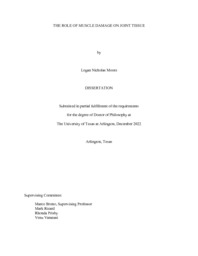| dc.description.abstract | The musculoskeletal system is a highly diverse network of tissue that operates in conjunction to one other, both mechanically and biochemically. In states of disorder such as musculoskeletal disorders, this cross-communication between tissues is pivotal in the progression of disease state in other tissues, or the prevention and healing of the effected tissue. Musculoskeletal disorders (MSkD) are a broad term encompassing disorders to bones, joints, muscles and connective tissues. These disorders include Osteoarthritis, Osteopenia, Sarcopenia, Tendonitis, Myopathies, and muscle weakness.
Osteoarthritis (OA) is the most common joint disorder, characterized as damage to the articulating cartilage and alterations in other joint tissues such as osteophytes and synovitis. Study 1 (Chapter 2) identifies the current mouse models used in OA studies and explores the advantages and disadvantages of each model. These models include inducing OA by means of genetic alteration, exercise, chemical injection, tibial loading, and the most common surgical induction. Each model has their advantages and disadvantages, and due to the complexities of OA no singular model is best at providing the complete pathophysiology of the disease. The current mouse models explain OA through injury or alteration directly to the joint and lack the causality of OA through indirect joint injury. Inducing acute muscle damage could provide a physiological and mechanistic causation to indirect joint injury in which OA could develop, study 3 (Chapter 4)
Biomarker analysis is essential in understanding the mechanisms in disorder regulation and provides molecular targets for intervention, therapies, and treatments. A technique for biomarker analysis is RNA sequencing (RNAseq), which provides complete transcriptome analysis in which details the differently expressed genes (DEGs). Synovium is soft tissue that lines the joint cavity, providing nutrients necessary for the joint's health and maintenance. Study 2 (Chapter 3) systematically explores the DEGs in the synovial tissue in subjects that have OA. There were 8 DEGs, MMP13, MMP1, MMP2, APOD, IL6, TNFAIP6, FCER1G, and IGF1 found to overlapped in 4 out of 5 included studies. These genes are related to the inflammatory pathway and regulation of the extracellular matrix. The MMP family, particularly MMP13 was identified by three of the studies, indicating its key role in OA. IL6, a key contributor in the inflammation pathway, was also identified in 3 studies. Further investigation with more clinical gene profiling in synovial tissue of OA subjects is required to reveal the causation and progression and aid in the development of new treatments.
Finally Study 3 (Chapter 4), details the physical, morphological, and biochemical alterations of joint tissues following acute muscle damage. It has been characterized as OA being accompanied by muscle weakness resulting from a lack of physical activity and atrophy. However, muscle weakness causes joint instability and an increased load on the joint. This cause joint alterations in the articular cartilage and in the subchondral bone. It is shown that there changes in peak heights in the Raman spectrum of the articulating cartilage that is indicative of alterations in the collagen composition. The µCT of the subchondral bone revealed increase in bon volume fraction. In response to muscle damage an inflammatory immune response occurs causing a release of pro-inflammatory molecules, such as cytokines, reactive oxygen species (ROS), and lipid signaling mediators (LMs). The LMs play a vital role in the muscle’s ability to regenerate from injury, as well as have downstream effects on other tissues in the musculoskeletal system. | |


